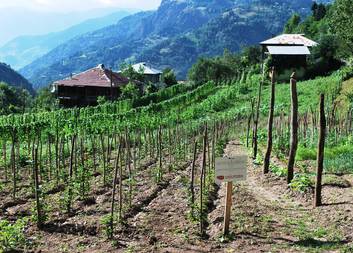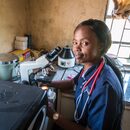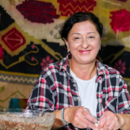Work continues to revive the traditional crops in the district of Khulo in the remote Adjara region of Georgia. Mountain slopes in the region of Maniakethi are planted with young trees of sour cherries, cherries, plums and hazelnuts by local farmers over 1.5 hectares. Newly restored benches will be covered by consumer grapes and blueberries.
 For the third year, local farmers and their families are supported by Caritas Czech Republic in a successful growth of popular local varieties of potatoes and fruit. This initiative provides them with permanent jobs in the local market.
For the third year, local farmers and their families are supported by Caritas Czech Republic in a successful growth of popular local varieties of potatoes and fruit. This initiative provides them with permanent jobs in the local market.
With the support of CCR, cultivation and storage of potatoes through building of warehouse and testing of drip irrigation on the local potato field has improved, which, in turn, improves the living conditions of farmers and ensure a friendlier attitude towards the environment. At the moment, CCRaims to promote planting orchards and vineyards on slopes and terraces that are threatened by landslides. The roots of trees help to anchor and strengthen slopes, preventing soil erosion. For the first time, larger orchards have been planted, which helped to restore the traditional terraces or kadoni with the backing of woven hazel branches.
The charity team gained the first practical experience with plantation of smaller plots of land in Didachara village in 2014. This year’s project is terracing and planting the slope in Maniakethi. Cherries, plums and hazelnuts will grow well here and grapes and blueberries will grow on renewed terraces. Thanks to the warm air from the sea, the exceptionally tasteful fruit is successfully cultivated at altitudes comparable to the highest mountains of the Krkonoše Range.  After the late harvest, the area could be developed as seaside resorts during the peak of tourist season.
After the late harvest, the area could be developed as seaside resorts during the peak of tourist season.
Guram Dzirkvadze, nicknamed “Michurin,” realized the benefits of fruit farming, and used his own funds to start the project. He participated in training on grafting fruit and grapevines in the leading Georgian nurseries. He will be in charge of the nursery in his homeland, Dioknisi, which was created in the past by Caritas Czech Republic. At his own expense he planted a hillside above the village to combat the threat of erosion. Before planting itself he prepared individual terraces for each tree to protect seedling against the snow and to facilitate watering and eventual healing.
Currently the land is already fenced in Maniakethi and terracing takes place in these first days of August, according to the plans that were worked out by landscaping expert Zaal Maghradze. Caritas Czech Republic believes that a pilot slope planting and restoration of terraces will show farmers of the whole region how to effectively defend against landslides and lead to additional  sources of livelihood in the mountains of Upper Adjara.
sources of livelihood in the mountains of Upper Adjara.
Farmers know that fruit farming can mean full-year profit, especially when they learn how to grow and proces the fruit and subsequently supply the market in the form of tempting sweets from organically grown dried fruit. That is why, in mid-June, Adjara women attended practical training led by Maia Mirvelashvili and Maia Barathashvili who are experts on pomology (studying varieties of fruit). Local women are testing candied raspberries, strawberries, plums, cherries and pears and they learned how to prepare chocolate glaze and icing from egg whites for dried fruit.
Already this year they will break into the market with locally manufactured and originally packed sweets. They will be the first to prove that even in the traditional Muslim Adjara society, women can enhance local markets with their new products.







